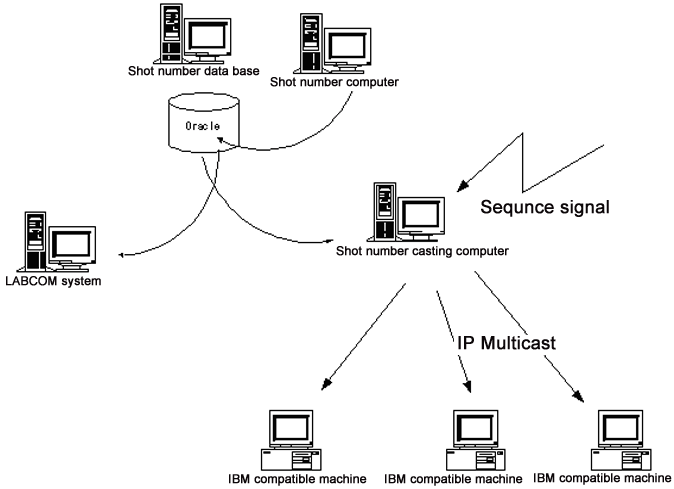



By distributing the information of LHD experimental sequence with shot number, each client can recognize the timings before and after every plasma discharge. IP Multicast makes it possible to automate the individual data acquisition and consecutive analysis among shot sequences. This service can be also available through the PV-WAVE/IDL programs.
◆Revised information◆
On 13/2/2006, a problem was found that the
routine dealing with long-pulse operations had some bugs and therefore multicast
routes occasionally disappeared on network. To fix it, we have modified that the
system will send HELO packets periodically. Please use the
fixed multicast client by downloading from here:
[download page].
![]()
To apply long-pulse experiments fully from LHD's 5th cycle, some parts of this service has been modified by LABCOM.
Multicast data information sample program ![]() (a Web page of Analysis Information Group)
(a Web page of Analysis Information Group)
The specification below is originally based on [Multicast
data information![]() ]
of Analysis Information Group. Explanations are corrected and
rearranged due to the service renewal.
]
of Analysis Information Group. Explanations are corrected and
rearranged due to the service renewal.
This service informs the progress of experimental sequence by IP multicast. Differed from broadcast, server load does not increase even though the number of clients were increased, because IP multicast packets will be sent only to the requesting clients.
At the present time, there are kinds of multicast on LHD network as follows;
Shot sequence + shot number information
Analysis data registration information ⇒ to
the homepage of Analysis Information Group![]() .
.

Abstract figure of system
Purpose
By casting the progress of shot sequence with test (shot) number, each client recognize the timing of before and after plasma discharge, Multi-cast makes it possible to automate the conduct of individual data collection, before and after shot, and data analysis after that.
Contents of transmission
Following information will be sent through this service;
progress status of shot sequence (S1~S10)
shot number
sub-shot number.
Shot number is always notified with sub-shot number. By using the sub-shot number, it is possible to save data by the synchronized operation of diagnostics instrument even if the time, when test sequence is not received at all and test number is not renewed during a long pulse discharge holding test, become long. In usual short pulse operation, sub-shot number is always 1.
Flows of shot sequence distribution service (ShotInfoService)
(*1) If the test number received from LMS is different with the last test number, replace the shot number with the number in LMS database and sub shot number with 1. If the test number in LMS database is not renewed, replace sub shot number with +1.
<Reference> LHD shot sequence
S1 ・・・ Sequence start. 2 min. 30 s before discharge
S2 ・・・ MG acceleration start
S3 ・・・ Diagnostics start. 2 min. 3 s before discharge
S4 ・・・ 1 min. before discharge
S5 ・・・ 30 s before discharge
S6 ・・・ 10 s before discharge
S7 ・・・ 3 s before discharge. Shot number is fixed. (Temporary number is used from S1 to S6.)
S8 ・・・ Discharge start. t=0
S9 ・・・ Discharge end. t=10 in case of short pulse discharge
S10 ・・・ Sequence end. t=30 in case of short pulse discharge
UDP/IP to be used
| IP address | 225.1.1.3 | → In steady state experiment, long pulse sequence is executed once per shot. |
| 225.1.1.4 | → In steady state experiment, 3min. cycle sequence is executed repeatedly. | |
| note) At 3min. cycle short pulse operation, the same sequence is executed in the above two cases. | ||
| TTL | 4 | |
| IP port number | 7000~ |
Format
Order of byte should be INTEL type.
Packet contents and kinds
0.Common parts
| Byte | Size | Type | Explanation |
| 0-3 | 4 | signed int | Packet ID An integer, no less than 1, indicates kind of packet. (At test sequence, ID=1) |
| 4-7 | 4 | signed int | Packet size |
| 8- | Variable | byte[] | Depended on packet ID. |
0'.Common HELO packet (packet ID=-1)
1.Test sequence (packet ID=1)
IP address 225.1.1.3 & 225.1.1.4 (common)
Port 7000
| Byte | Size | Type | Explanation |
| 8-11 | 4 | signed int | Sequence condition Variable within 1 to 10 according to test sequence (S1~S10) progress. When sequence stop, this is 0 (225.1.1.4 is variable within 3 to 9 more few times according to the progress of repeat collection sequence.) |
| 12-15 | 4 | signed int | Shot number |
| 16-19 | 4 | signed int | Sub shot number |
2.Data collection progress observation (packet ID=4)
IP address 225.1.1.5
Port 7001~ (7000+” ID number (diag_id,no less than 1) of individual diagnostics”.)
| Byte | Size | Type | Explanation |
| 8-11 | 4 | signed int | Shot number |
| 12-15 | 4 | signed int | Sub shot number |
| 16-19 | 4 | signed int | ID number (diag_id) of individual diagnostics. |
| 20- | variable | ・・・ | ・・・ (As of May 5th 2005, being designed) |